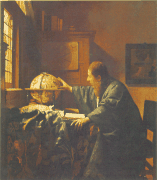The Astronomer
Paris, Louvre
50x45 1668
 (Large)
(Large)
This painting is intimately linked with The Geographer:
they were recorded together in 1713, and sold together in 1729.
These paintings reflect the blossoming of
scientific enquiry in seventeenth century Europe. At this time, Newton
is making the first reflecting telescopes, Louis XIV is building an
observatory in Paris, the satellites of Jupiter
are being used for navigation at sea, and Huygens has discovered the
sixth satellite of Saturn. The old views, that it would be presumptive
for man to probe too closely the sky or the Earth, are being replaced
by modern principles of science.
Vermeer was a friend of
Antoni van Leeuwenhoek, born in the same year, 1632,
and living in the same city, Delft. Van Leeuwenhoek invented the microscope,
and discovered the cell structure of biological systems, spermatozoa,
and bacteria; he was also skilled in navigation, astronomy, mathematics.
Furthermore, he was the trustee of Vermeer's estate, and he may be the
subject of these two portraits.
The portrait of Van Leeuwenhoek by Jan Verkolje
seems to have similar features, and also includes a celestial globe.
The astronomer is dressed in a loose robe, his hair behind one ear,
a scholar with his passion; he is looking at a book and an accurately
rendered celestial globe, made by Jodocus Hondius in 1600.
On the table, on a rich oriental tapestry, is an astrolabe, precursor
of the sextant; above the globe is a circular chart with radial lines of
obscure significance.
Behind the astronomer is a painting: The Finding of Moses,
symbolizing the new discoveries being made in science at the time.
Brought to you by
BallAndClaw.com.
 (Large)
(Large)